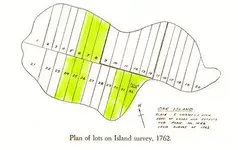n2mini.......
Nothing I post about Smith's Cove has anything to do about the Money Pit or even if there was or was not a treaure on Oak Island, I don't believe the two were connected in any way. The more things that have been claimed and NOT ever found, or like the flood tunnel from Smith's Cove, proven by Dunfield to not exist, the less I believe in any treasure having ever been there. The things claimed to have been found that have all been 'lost' in one way or another, do not add to believing in any way.
What we do know is there were structures built in and around Smith's Cove, the physical evidence of those structures has been well documented. That is what I am looking at, how they could be used and to what purpose, why they would be needed in the first place. I am more than happy to look at anyone else's ideas on why they were built, I am not closed minded in thinking the salt plant is the right answer, only in it being the most plausible with what we now know. The circumstantial evidence of the fishing company owning the island as well as the fishing rights in the area, their need for salt as part of their day to day business, only lend to that plausibility. 100% proof? of course not, as nothing short of seeing actual photo's of it in operation would satisfy everyone, and even then some would say, nope, BUT offer no other plausible ideas as to what these structures not only were used for, but why there was a need for them in the first place.
Dennis Kings article has been linked to many times in this thread, few have bothered to read it apparently, wanting others to do ALL of the research for them, so they then can discount it with out ever having bothered to do look for those answers to questions they have with their own research.
Yes, there are other 'proof's' of the whole fishing industry in the area from the 1580's forward, easily found if one looks...Yes, the New York fishing company is known to have owned Oak Island in 1753, several sources state as much....common sense at some point has to be applied to what they would use the island for in their fishing business and what part Smith's Cove would play in that.
I believe it to be a salt works, as the need and what we DO know, points that way more than any other for me. I am not trying to convince anyone it IS a salt works. You are welcome to do some research and come up with your own reasons of what it could be. As stated, I would be glad to see other ideas, none have been forthcoming, only statements that is IS not a salt works, based on....nothing.
I also have stated this pc is working so slow I am not willing to spend hours refinding the information, that I have researched, to provide links to those that say it can't be, while offering NO idea as to what it could be. Two reasons for this, one it can never be proven 100% either way, no matter what links are posted (that most won't even bother to go read as they are long drawn out articles) and so is a waste of time, mine. Two, from the research I have done, not only into the physical items known to be in Smith's Cove, but also into the history of salt making in this time period in all parts of the world and how it would apply to Oak Island and the fishing industry there...I have satsified myself that this is what Smith's Cove was being used for...Nothing I could post would change the minds of those that disagree, and that is fine, that is not my intent.
I was hoping for different views, not just the naysayers, so far, nothing.
So with that, this is over for me...everyone can research, and more importantly, believe whatever they want, as in the long run it will make no difference at all....
45 minutes to write this, so until it is repaired next week...only small blurbs will come out of it...Thanks!






